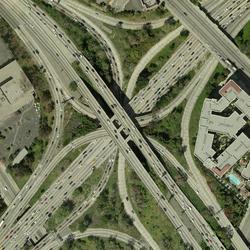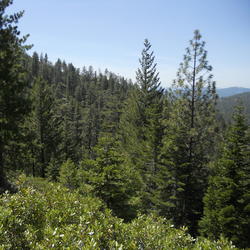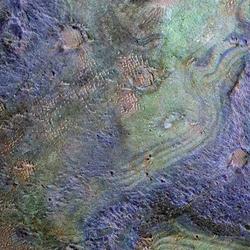Induced Seismicity Associated with Carbon Dioxide Geologic Storage
Microseismic Monitoring at Decatur, IL
The USGS monitors microseismic activity to better understand the possible hazard associated with deep-well injection of carbon dioxide at Decatur
As a national science agency, the USGS is responsible for assessing hazards from earthquakes throughout the United States. The USGS studies induced seismicity across the spectrum of energy issues: carbon sequestration, geothermal energy, and conventional and unconventional oil and gas. In the central and eastern United States, earthquakes induced by fluid injection activities contribute significantly to the total seismic hazard, partly because the modern boom in oil and gas production is taking place in this vast region and because the background level of seismicity is relatively low in this geologically stable part of country.
Geologic Carbon Dioxide Utilization Topics
This task, which is also supported by the USGS Natural Hazards Mission, is operating a dedicated seismic network at the Decatur, IL, CO2 sequestration site to study the potential for induced seismicity related to CO2 storage in regionally extensive sedimentary formations. Given the importance of geologic carbon storage to our energy and climate future, we are assessing if injecting super-critical CO2 into deep formations is similar to the injection of comparable volumes of wastewater with regard to causing earthquakes. The seismic network in Decatur provides some of the important information needed to achieve this goal. Lessons learned will be applied not only to the Decatur injection project, but also to future geologic carbon storage projects to ensure that these facilities are designed and operated as safely as possible.
Data from the seismic network is publicly accessible at the IRIS+ data management center (network code=GS, stations=DEC*)
Slideshows Associated with Project Member Talks:
- Overview of USGS Carbon Sequestration - Geologic Research and Assessments Project [.pdf] [2.1 MB]
- Microseismicity Monitoring at the Decatur, IL, CO2 Sequestration Demonstration Site [.pdf] [8.9 MB]
- Induced Seismicity Monitoring at the Decatur, IL, CO2 Sequestration Demonstration Site [YouTube]
Below are other science projects associated with this project task.
Carbon and Energy Storage, Emissions and Economics (CESEE)
Economics of Energy Transitions
Geologic Energy Storage
Assessing Emissions from Active and Abandoned Coal Mines
Geologic Carbon Dioxide and Energy-related Storage, Gas Resources, and Utilization
Methodology Development and Assessment of National Carbon Dioxide Enhanced Oil Recovery and Associated Carbon Dioxide Storage Potential
Below are publications associated with this project task.
Physical properties of sidewall cores from Decatur, Illinois
Surface monitoring of microseismicity at the Decatur, Illinois, CO2 sequestration demonstration site
Seismic monitoring at the Decatur, Ill., CO2 sequestration demonstration site
Below are news stories associated with this project task.
Below are FAQ associated with this project task.
How does carbon get into the atmosphere?
Atmospheric carbon dioxide comes from two primary sources—natural and human activities. Natural sources of carbon dioxide include most animals, which exhale carbon dioxide as a waste product. Human activities that lead to carbon dioxide emissions come primarily from energy production, including burning coal, oil, or natural gas. Learn more: Sources of Greenhouse Gas Emissions (EPA)
Has the USGS made any Biologic Carbon Sequestration assessments?
The USGS is congressionally mandated (2007 Energy Independence and Security Act) to conduct a comprehensive national assessment of storage and flux (flow) of carbon and the fluxes of other greenhouse gases (including carbon dioxide) in ecosystems. At this writing, reports have been completed for Alaska , the Eastern U.S. , the Great Plains , and the Western U.S. Learn more: Land Change Science...
How much carbon dioxide does the United States and the World emit each year from energy sources?
The U.S. Energy Information Administration estimates that in 2019, the United States emitted 5,130 million metric tons of energy-related carbon dioxide, while the global emissions of energy-related carbon dioxide totaled 33,621.5 million metric tons.
Which area is the best for geologic carbon sequestration?
It is difficult to characterize one area as “the best” for carbon sequestration because the answer depends on the question: best for what? However, the area of the assessment with the most storage potential for carbon dioxide is the Coastal Plains region, which includes coastal basins from Texas to Georgia. That region accounts for 2,000 metric gigatons, or 65 percent, of the storage potential...
How much carbon dioxide can the United States store via geologic sequestration?
In 2013, the USGS released the first-ever comprehensive, nation-wide assessment of geologic carbon sequestration , which estimates a mean storage potential of 3,000 metric gigatons of carbon dioxide. The assessment is the first geologically-based, probabilistic assessment, with a range of 2,400 to 3,700 metric gigatons of potential carbon dioxide storage. In addition, the assessment is for the...
What’s the difference between geologic and biologic carbon sequestration?
Geologic carbon sequestration is the process of storing carbon dioxide (CO2) in underground geologic formations. The CO2 is usually pressurized until it becomes a liquid, and then it is injected into porous rock formations in geologic basins. This method of carbon storage is also sometimes a part of enhanced oil recovery, otherwise known as tertiary recovery, because it is typically used later in...
What is carbon sequestration?
Carbon dioxide is the most commonly produced greenhouse gas. Carbon sequestration is the process of capturing and storing atmospheric carbon dioxide. It is one method of reducing the amount of carbon dioxide in the atmosphere with the goal of reducing global climate change. The USGS is conducting assessments on two major types of carbon sequestration: geologic and biologic .
Below are partners associated with this project task.
As a national science agency, the USGS is responsible for assessing hazards from earthquakes throughout the United States. The USGS studies induced seismicity across the spectrum of energy issues: carbon sequestration, geothermal energy, and conventional and unconventional oil and gas. In the central and eastern United States, earthquakes induced by fluid injection activities contribute significantly to the total seismic hazard, partly because the modern boom in oil and gas production is taking place in this vast region and because the background level of seismicity is relatively low in this geologically stable part of country.
Geologic Carbon Dioxide Utilization Topics
This task, which is also supported by the USGS Natural Hazards Mission, is operating a dedicated seismic network at the Decatur, IL, CO2 sequestration site to study the potential for induced seismicity related to CO2 storage in regionally extensive sedimentary formations. Given the importance of geologic carbon storage to our energy and climate future, we are assessing if injecting super-critical CO2 into deep formations is similar to the injection of comparable volumes of wastewater with regard to causing earthquakes. The seismic network in Decatur provides some of the important information needed to achieve this goal. Lessons learned will be applied not only to the Decatur injection project, but also to future geologic carbon storage projects to ensure that these facilities are designed and operated as safely as possible.
Data from the seismic network is publicly accessible at the IRIS+ data management center (network code=GS, stations=DEC*)
Slideshows Associated with Project Member Talks:
- Overview of USGS Carbon Sequestration - Geologic Research and Assessments Project [.pdf] [2.1 MB]
- Microseismicity Monitoring at the Decatur, IL, CO2 Sequestration Demonstration Site [.pdf] [8.9 MB]
- Induced Seismicity Monitoring at the Decatur, IL, CO2 Sequestration Demonstration Site [YouTube]
Below are other science projects associated with this project task.
Carbon and Energy Storage, Emissions and Economics (CESEE)
Economics of Energy Transitions
Geologic Energy Storage
Assessing Emissions from Active and Abandoned Coal Mines
Geologic Carbon Dioxide and Energy-related Storage, Gas Resources, and Utilization
Methodology Development and Assessment of National Carbon Dioxide Enhanced Oil Recovery and Associated Carbon Dioxide Storage Potential
Below are publications associated with this project task.
Physical properties of sidewall cores from Decatur, Illinois
Surface monitoring of microseismicity at the Decatur, Illinois, CO2 sequestration demonstration site
Seismic monitoring at the Decatur, Ill., CO2 sequestration demonstration site
Below are news stories associated with this project task.
Below are FAQ associated with this project task.
How does carbon get into the atmosphere?
Atmospheric carbon dioxide comes from two primary sources—natural and human activities. Natural sources of carbon dioxide include most animals, which exhale carbon dioxide as a waste product. Human activities that lead to carbon dioxide emissions come primarily from energy production, including burning coal, oil, or natural gas. Learn more: Sources of Greenhouse Gas Emissions (EPA)
Has the USGS made any Biologic Carbon Sequestration assessments?
The USGS is congressionally mandated (2007 Energy Independence and Security Act) to conduct a comprehensive national assessment of storage and flux (flow) of carbon and the fluxes of other greenhouse gases (including carbon dioxide) in ecosystems. At this writing, reports have been completed for Alaska , the Eastern U.S. , the Great Plains , and the Western U.S. Learn more: Land Change Science...
How much carbon dioxide does the United States and the World emit each year from energy sources?
The U.S. Energy Information Administration estimates that in 2019, the United States emitted 5,130 million metric tons of energy-related carbon dioxide, while the global emissions of energy-related carbon dioxide totaled 33,621.5 million metric tons.
Which area is the best for geologic carbon sequestration?
It is difficult to characterize one area as “the best” for carbon sequestration because the answer depends on the question: best for what? However, the area of the assessment with the most storage potential for carbon dioxide is the Coastal Plains region, which includes coastal basins from Texas to Georgia. That region accounts for 2,000 metric gigatons, or 65 percent, of the storage potential...
How much carbon dioxide can the United States store via geologic sequestration?
In 2013, the USGS released the first-ever comprehensive, nation-wide assessment of geologic carbon sequestration , which estimates a mean storage potential of 3,000 metric gigatons of carbon dioxide. The assessment is the first geologically-based, probabilistic assessment, with a range of 2,400 to 3,700 metric gigatons of potential carbon dioxide storage. In addition, the assessment is for the...
What’s the difference between geologic and biologic carbon sequestration?
Geologic carbon sequestration is the process of storing carbon dioxide (CO2) in underground geologic formations. The CO2 is usually pressurized until it becomes a liquid, and then it is injected into porous rock formations in geologic basins. This method of carbon storage is also sometimes a part of enhanced oil recovery, otherwise known as tertiary recovery, because it is typically used later in...
What is carbon sequestration?
Carbon dioxide is the most commonly produced greenhouse gas. Carbon sequestration is the process of capturing and storing atmospheric carbon dioxide. It is one method of reducing the amount of carbon dioxide in the atmosphere with the goal of reducing global climate change. The USGS is conducting assessments on two major types of carbon sequestration: geologic and biologic .
Below are partners associated with this project task.
















